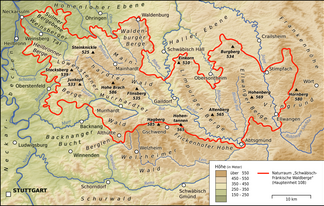Waldenburg mountains
| Waldenburg mountains | |
|---|---|
|
Waldenburg Mountains in the north of the Swabian-Franconian Forest Mountains |
|
| Highest peak | Mühlberg ( 523.7 m above sea level ) |
| location | Baden-Wuerttemberg , Germany |
| part of | Swabian-Franconian Forest |
| Coordinates | 49 ° 10 ′ N , 9 ° 40 ′ E |
| Type | Mountain country |
|
The Waldenburg Mountains from the western point of view from Öhringen |
|
The Waldenburg mountains are up to 523.7 m above sea level. NHN high, wooded ridge in the districts of Schwäbisch Hall and Hohenlohe in Baden-Württemberg ( Germany ).
At the same time, the Waldenburg Mountains are one of five forest regions of the Swabian-Franconian Forest Nature Park , which represents the western part of the Swabian-Franconian Forest . Its name is derived from the town of Waldenburg , located on the northern edge of the forest area .
geography
The Waldenburg Mountains are located in the northeast part of the above-mentioned nature park a little over 50 km northeast of Stuttgart and about 30 km (as the crow flies ) east of Heilbronn between the Hohenlohe Plain in the north, the Hall Plain in the east, the Limpurg Mountains in the southeast and the Mainhardt Forest in the south and southwest. According to the structure of the manual of the natural spatial structure of Germany by Meynen / Schmithüsen (1953–1962) they represent the natural spatial unit 108.5 of the Swabian-Franconian forest mountains in the Swabian Keuper-Lias-Land .
They are located directly south of Waldenburg, not far west of Schwäbisch Hall , north and northwest of Michelfeld , a few kilometers northeast of Mainhardt and a little east of Pfedelbach .
mountains
The elevations of the Waldenburg mountains include - with height in meters (m) above sea level (NHN):
- Mühlberg ( 523.7 m ), approx. 1 km east-southeast of Goldbach
- Friedrichsberg ( 517.1 m ), with the Waldenburg-Friedrichsberg transmission tower ; less than 2 km east-southeast of Waldenburg
- Theresienberg ( 497.6 m ); approx. 1 km west of Waldenburg
Waters
The two most important rivers of the Waldenburg Mountains are the Bibers , which flows south-south-east through the eastern part of the forest landscape and then via Michelfeld to Rosengarten and flows into the upper Kocher , as well as the Ohrn , which draws the border to the Mainhardter Forest and north-north-west via Öhringen into the lower Kocher flows. The copper , which belongs to the Hohenlohe plain along its entire length, collects some left streams from the slope of the Waldenburg mountains at the eastern foot of the mountain landscape and then flows via Kupferzell to Forchtenberg , where it also flows into the lower Kocher .
The still waters of the Waldenburg Mountains include:
- the small Burgvogtsee south of Waldenburg-Streithof, origin of the beavers
- the Neumühlsee ( bathing lake with campsite ) through which the upper Beaver flows and is located in the northern part of the forest landscape near the hamlet of Laurach
- the Rößlesmahdsee ( nature reserve ) and the Goldbachsee at their left inlet Goldbach
- a forest pond at the Entlesboden nature reserve near Waldenburg-Tommelhardt, which also drains into the Bibers
- the Sailach reservoir further down the valley in the Biberslauf north of Michelfeld-Gnadental
- two larger ponds in the forest on the plateau west of Michelfeld-Forsthaus, which drain over the Schupbach into the Ohrn.
The flat plateau between the Biberstal in the east and the Ohrntal in the west is often quite humid in its forested areas and widely crossed by drainage ditches. Heaped dams that are now functionless on level terrain, such as on the Oberen Weide east of Waldenburg-Obersteinbach, indicate older lakes that were abandoned at some point.
To the east of Michelfeld-Wagrain there is a small "growing brook" on the slope with sinter formations between a field path and a field hedge.
Geology and Protected Areas
The slightly inclined, wooded plateau of the Waldenburg Mountains, which is traversed by the valleys of the aforementioned flowing waters, consists of layers of the Mittelkeuper . Gipskeuper , reed sandstone and the lower colored marl form the ascent . Most of the plateau is covered by silica sandstone . In the south around Neunkirchen, Witzmannsweiler and Büchelberg, the sequence of layers extends over the Upper Bunter Marl to the Stubensandstein .
There are several nature reserves in the Waldenburg Mountains area :
- Cattle pasture on the Michelberg mark near Michelbach , No. 1010
- Entlesboden near Obersteinbach , No. 1011
- Kupfermoor near Untermünkheim - Kupfer , No. 1018, on the eastern edge
- Rößlesmahdsee with Pfaffenklinge near Beltersrot , No. 1110
- Einberg near Untersteinbach , No. 1146
- Obere Weide , also near Obersteinbach, No. 1236
history
Monks and nuns were always drawn to the seclusion of the Waldenburg Mountains. Thus, in Gnadental and Goldbach monasteries ( monastery Gnadental and monastery Goldbach ) established that were lifted in the 16th century.


